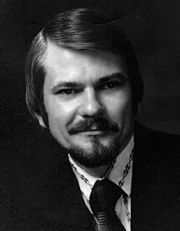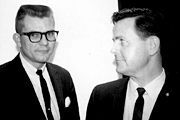Refund requests are an unavoidable part of running a chiropractic practice. Whether a patient is unhappy with their care, believes an adjustment caused harm, or simply changes their mind, these situations must be handled carefully to avoid escalation. While chiropractors are not legally obligated to issue refunds in most cases, there are times when doing so is the best business decision to protect the practice.
Remembering Dr. David S. Walther
Dr. David Walther, a 1959 graduate of Palmer College of Chiropractic and one of the most prolific writer-researchers in the chiropractic profession, passed away peacefully in his sleep on Sept. 10, 2008. With Jeanne, his beloved wife and publishing partner for 44 years, Dr. Walther's writings and teachings about applied kinesiology (AK) crossed the globe, influencing thousands of DCs.
His father and mother (Norman and Rose Walther) were both chiropractors who met and married at Palmer in 1926. David graduated in 1959 at the end of B.J. Palmer's career there, and was the chairman of the Delta Sigma Chi fraternity.
Shortly after starting practice with his father in Pueblo, Colo., Dr. Walther chaired the education committee of the Colorado Chiropractic Association (CCA). It was during this period that he first invited Dr. George J. Goodheart Jr. to lecture on the topic of manual muscle testing and grew fascinated with the increased possibilities for chiropractic diagnosis using Goodheart's methods.

Prior to teaching AK, Walther was active in the two Colorado chiropractic organizations, and from his second year in practice served on the board of directors or as an officer of one of them. From 1970-1971, Walther and a handful of his colleagues worked to get the two organizations (one a mixer, the other straight) to form a unified group. One of the things of which he was most proud was his selection as the first president of the combined organization, which is now the CCA. He received the CCA Outstanding Service Award in 1967 and 1976, and the Chiropractor of the Year Award in 1973.
In 1976, Dr. Walther resigned from all management activities with the CCA to devote more time to developing educational materials on AK. He became an avid practitioner of AK and a philosopher, researcher, encyclopedist and educator of its possibilities for patient health care. His chiropractic library was one of the largest in the world in private hands.
The first text Dr. Walther wrote on AK, Applied Kinesiology - The Advanced Approach in Chiropractic, was published in 1976, and all certified teachers of AK immediately began using it as the recommended text. Programmed instruction workbooks accompanied the initial text, and Walther produced more than 10,000 slides as part of the audiovisual instruction program for AK teachers around the world. He was the primary developer of the 100-hour basic course syllabus adopted by the International College of Applied Kinesiology (ICAK).

Walther's second text, Applied Kinesiology, Volume 1 - Basic Procedures and Muscle Testing (1981), covers the basic procedures of AK and introduced the breadth of MMT procedures to the chiropractic profession and the world. Applied Kinesiology,Volume II - Head, Neck, and Jaw Pain and Dysfunction, The Stomatognathic System (1983) was his third book on AK, covering the cranialsacral primary respiratory system. The use of the MMT in cranial therapy added another examination tool for the discovery of disorders in this subtle and complex system.
Dr. Walther also wrote chapters in several dental textbooks on the examination and treatment of the stomatognathic system, which includes the cranium, temporomandibular joint and cervical spine, how these structures influence the rest of the body and how the rest of the body influences it. This text is used by many dentists and has helped develop closer relationships between dentists and chiropractors.
Dr. Joe Keating, in his book Toward a Philosophy of the Science of Chiropractic (1992), cited Walther's textbooks on AK as classics of the chiropractic clinical literature. Based on sales, it is estimated that approximately half of the practicing chiropractic profession has his basic textbook on AK.
Dr. Walther wrote each of these seminal texts while maintaining a thriving practice in Pueblo. At the time of his passing, he was working on three additional textbooks in the series: Volume III, on the meridian system; Volume IV, on orthopedic conditions; and Volume V, on systemic conditions.
Because each textbook took him several years to complete, Walther's Applied Kinesiology: Synopsis, covering each of the subject areas in the texts, was published in 1988, with a second edition in 2000. These textbooks on AK chiropractic technique have been translated into Italian, Korean, French and German. The Chukyo College of Chiropractic in Nagoya, Japan, translated his textbooks into Japanese.
Dr. Walther's ability to resume his chiropractic clinical writing even after the busiest days and most distracting interruptions in the clinic was one of his great qualities as a chiropractic clinician-scientist. To resume work on his textbooks was almost a natural act for him because for 49 years, what he wanted most in the world was to work with the sick and teach others how to do it better.
Walther reveled in the process of patient education and wrote more than 61 patient education pamphlets for many of the conditions chiropractors face in their practices. These pamphlets (distributed by his publishing company, Systems DC) are in the offices of doctors around the world, educating patients on the full scope of chiropractic practice.
One of Dr. Walther's major efforts was to integrate the new material developed in AK with the standard database of knowledge in anatomy, physiology, and accepted examination procedures. His work mainstreamed many of the procedures developed by Goodheart and the ICAK community, as evidenced by the presence of his textbooks in so many chiropractic and CAM college bookstores and libraries around the world.
Walther's knowledge and abilities were recognized by the fact that he was invited to write chapters for a number of textbooks, including Principles and Practice of Manual Therapeutics: Medical Guides to Complementary & Alternative Medicine (published in 2002), New Concepts in Craniomandibular and Chronic Pain Management (1994), and Holistic Medicine (1982).
VOICE (the Voluntary Organization of Independent Chiropractic Educators) made Dr. Walther a charter member in 1978 because he was an "eminent and recognized chiropractic independent researcher and educator" in teaching postgraduate continuing education programs. He was a trustee of the Foundation for Allied Conservative Therapies Research and was also honored with The Fullness of Life Foundation's Humanitarian Award.
From the mid-1970s to late 1980s, Walther lectured about AK throughout the U.S., Canada, Europe, Australia and Japan. His seminars with Dr. Goodheart introduced AK to Japan and throughout Europe. He also lectured at a number of Parker Chiropractic Research Foundation
seminars on a regular basis for five years in the 1980s and was Parker's Chiropractor of the Year in 1981. He served on the board of directors of the ICAK-USA from 1976 until 1999.
Walther was also a truly brilliant mechanic, built a Cybex II dynamometer and purchased considerable equipment like the mandibular kinesiograph to help evaluate what we are doing with AK procedures. From this equipment, considerable information was added to his textbooks.
I had the privilege of working with David during the final nine years of his life in our clinic in Pueblo. He was always the master clinician, and I experienced the incessant productivity and clinical brilliance of his mind in daily chiropractic life and care through his example. Through David Walther, I learned that AK is not a separate part of the work of D.D. Palmer. Rather, it is an integrated component within the science of chiropractic. Dr. Walther taught countless thousands of doctors and potentially millions of patients that AK is the living application of the science of chiropractic.
Due to Walther's efforts, applied kinesiology was presented to the world in a way that many more people could understand and use. In his final years, I felt sure David could see what a massive contribution to the health and welfare of the world his life's work had been. The chiropractic profession will be forever indebted to this unique individual for the many ways he enhanced the health care field. Rest in peace, David Walther, and thank you for everything you have given us.


